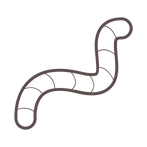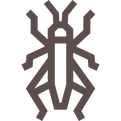Agalychnus callidryas- Red-Eyed Tree Frog
The red-eyed tree frog is not poisonous, despite their bright coloration. They can excrete toxins from their skin like many frogs. This tropical tree frog is found in southern Mexico, throughout Central America and in northern South America. They conceal their brightly colored flanks with their limbs during the daytime to sleep and close their eyes which has a third eyelid, called a nictitating membrane, to help conceal the color while still allowing them to see. They use their bright coloration to startle predators while they escape.
|
Bringing Home Your New Pet
When you bring your new frog home, you should already have a quarantine tank set up and ready to go. Place fresh water in a bowl in the tank, mist the tank and offer food, but be aware it is completely normal for them to refuse food for the first couple days, or even longer. You should keep this new frog separate from any other reptiles you may have for 90 days, to ensure there is nothing it could spread to your other animals. Monitor its eating and fecals as they may be strange for up to a couple weeks, but this is due to a new diet, supplements, and environment. It is recommended you do not handle your new frog for the first 24-48 hours and keeping it to a minimum until it has started eating on its own. Always keep in mind, your new animal is in a new tank, with new decor/dishes/hides, and new faces watching them. They need time to become acclimated to it all. After this quarantine process, they can be safely introduced to their permanent enclosure if it's not already. Be sure to wash your hands before handling any other reptiles during this time. Always purchase captive bred animals when possible, to avoid disease and parasites. |
|
Enclosure Red-eyed tree frogs are not a large frog, but they require plenty of space. An 18" x 18" x 24" terrarium is minimum for 1-2 frogs. Add more space if you add more frogs. If your enclosure is not heavily planted, consider adding paper to the sides to offer more security, as these frogs do not understand clear barriers. They love to climb, so arboreal space will be used. They are active frogs at night, and will jump or climb around every inch of their enclosure. |
|
Substrate
Red-eyed tree frogs are rather messy, but require a clean environment to stay healthy. Loose substrate is not recommended unless you choose bioactive. Layer of paper towel can be used and changed out daily. Frog foam, which is a trim-to-size thick spongy foam that can be rinsed is highly recommended as it is easy to clean. Do not use pebbles or gravel as the risk of impaction is high. Spot clean often. |
|
Heating
Red-eyed tree frogs are cold blooded, so they rely on their environment to regulate body temperature. Most tree frogs do fine at room temperature, but will appreciate a temperature gradient if one is offered. Be sure the tank is big enough to allow them to move where they are most comfortable. Aim for temperatures of 72-78° F daytime ambient. A night time drop is natural, but don't allow temperatures to fall under 65° F. A basking spot can be offered with a low watt bulb or a heating pad on one side of the tank. Place light on a thermostat if necessary to be sure the warm spot doesn't get too hot. Basking temperatures should be between 80-85° F and be plenty high enough in the enclosure so the frogs have a varied temperature range to thermoregulate. |
|
Lighting
Red-eyed tree frogs are nocturnal, meaning they are most active at night! They should be exposed to 10-12 hours of light per day. They benefit from exposure to UVB lighting, so offering it for your frog is a healthy addition to their environment. Place lights on a timer to offer a natural day and night light cycle. |
|
Cage Decor
Red-eyed tree frogs are very active at night and need a lot of climbing surfaces. Fake or live plants are just fine, but should be broad leaved and able to withstand their bodies. Live trailing plants like Pothos are a wonderful addition to your frog enclosure. Vines and cork bark are also good, sturdy decor, as well as magnetic ledges for them to perch on. Blocking out the back and/or sides with paper, cork or backgrounds will help your frogs feel more secure. |
|
Humidity and Shedding
Red-eyed tree frogs are tropical, and require a moderate humidity level of around 60-85%. Make sure your enclosure has enough air flow so the air does not become stagnant. Mist 1-3 times a day to help keep the humidity up, but allow the enclosure to dry out between misting. It should not constantly be wet. Humidity fluctuations are healthy. Red-eyed tree frogs will shed their skin and ingest it, so if you notice your frog is particularly slimy looking, they are likely about to shed! |
|
Water
Your frog should have access to water to soak in that is deep enough to cover most of their bodies, but not so deep they can't easily get in and out of the bowl. Change this water daily and treat with water conditioner as frogs are very sensitive to contaminates in the water. Clean the bowl throughly between each water change. Check daily to be sure they have not soiled their water, and change immediately if they have. Frogs like to use their water dishes as latrines. |
|
Feeding
Red-eyed tree frogs are insectivores and love to eat. Turkestan red runner roaches and crickets should be the staple of their diets. Insects should be gutloaded with a commercial gutload product. Gutloading refers to the practice of feeding the insects a nutritious diet before offering them to your frog, to ensure the most balanced nutrition. Your frog should be fed based on temperatures and size of frog. Young, growing frogs kept in warmer conditions will eat more often and more at a time than a larger frog kept cooler. Feed babies and young frogs daily. Typically for adults, offering 3-5 food items 2-3 times a week is sufficient. |
|
Handling
While these frogs are more adapted to handling because of their docile nature, they still have sensitive skin so handling should be avoided or done with caution. However if you do handle your frog be sure to wash any lotions or perfumes off your skin first, as all frogs are sensitive to lotions, perfumes and oils. Wash your hands after handling them as well. They have a very long reach because of their long limbs, so be cautious to not harm them when handling. |




























